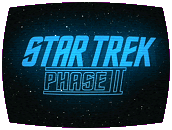This is an episode of a fan-made series whose storyline may be invalidated by later official studio productions.
Stardate 6010.1: No sooner has the Enterprise emerged from spacedock following a refit than a distress call is received from a cantankerous Starbase commander, who later sends another message: the emergency is over, thanks to the intervention of someone named Onabi. A suspicious Captain Kirk orders the Enterprise to proceed there anyway, where he and the Enterprise crew meet Onabi for themselves, and discover that she has a closer connection to the unknown alien threat than the Starbase personnel suspect.
written by Jack Marshall
directed by Jack MarshallCast: James Cawley (Captain Kirk), Jeffery Quinn (Mr. Spock), John Kelley (Dr. McCoy), Jack Marshall (Scott), Jay Storey (Kyle), Julienne Irons (Uhura), Meghan King Johnson (Rand), Ron Boyd (DeSalle), Jasen Tucker (Chekov), Jay Storey (Kyle), Larry Nemecek (Cal Strickland), John Winston (Captain Jefferies), Eddie Paskey (Admiral Leslie), Andrea Ajemian (Onabi), Mark Strock (Ohn), Shawn David (Security Officer), Pearl Marshall (Security Officer), Jeff Mailhote (Security Officer), Ed Kaczmarek (Mr. Leslie), Ed Abbate (Crewman), Timothy Sheffield (Crewman), Michel Anderson (Crewman), Anthony Laviano (Crewman), Jerry Yuen (Crewman)
Review: At the time this first effort by James Cawley and the determined Star Trek: New Voyages crew hit the internet, it was a revelation for most folks who weren’t on the inside curve when it came to fan films. Arguably, the media interest in their efforts not only put New Voyages and other Trek fan films on the map, but drew more attention to fan-made continuations of existing “universes” in general. In the minds of some diehard Trek fans, it was also a ballsy, defiant gesture to Paramount: if you don’t make the Star Trek we want to watch (a vocal faction of fandom was disappointed in the then-current series Star Trek: Enterprise), we’ll make it ourselves.
Come What May, by the standards of the “episodes” New Voyages (later Star Trek: Phase II) would be turning out just a couple of years later, is uneven. It’s all one big experiment, and the seams are showing in a big way. Among many other things, it seems that no one could make up their minds just how they wanted this story to fit into the Trek universe. It’s set during the original five-year mission, of course, but there seem to be clear pointers toward the movies (i.e. Sulu off the ship to attend command training) and beyond. The flash-forwards that occur as the alien life form comes into contact with the crew are a bit of a crap shoot – sometimes they work wonderfully (Kirk
glimpsing Spock’s Star Trek II death, and his own demise re-enacted from Star Trek: Generations), sometimes they just make me go “huh?” (Spock’s wedding – apparently to Chapel – and a scene which seems to indicate Kirk somehow survives Generations).
The seams show with some of the acting as well. As much as I’ve come to appreciate what the various main cast members bring to their interpretations of their beloved roles, the guest stars rule the day here, starting in the teaser with “Star Trek: The Next Generation Companion” author Larry Nemecek as a feisty starbase commander who seems to have no difficulty finding things to complain about, to the extremely cute Andrea Ajemian as the mysterious being who hassles the Enterprise crew. It’s all amateur-hour stuff, to be sure, with James Cawley letting his “Elvis” stage persona bleed through to his portrayal of Kirk more here than in any other New Voyage, but it is, after all, a fan film.
The production quality is nowhere near the level that New Voyages would later enjoy; in places, it looks a bit like it was shot on VHS in 1987. This is most likely a side-effect of the state of computer-based editing and compositing at the pro-consumer level circa 2004; the 3-D animation of such things as the Enterprise revealed as she leaves the Franz Joseph-designed spacedock is whole orders of magnitude sharper. If nothing else, it just shows har far New Voyages has come.
But there are other aspects that show it even more. Come What May is tracked with just about the clumsiest hodgepodge of Star Trek music imaginable, leaping from classic ’60s episode scores to music from the various movies and even Next Generation with reckless abandon. It’s interesting in places (Kirk’s opening log entry about the changes evident at the five-year mission’s halfway point is set to the tune of a piece of wistful Star Trek VI music, which is just inspired) but becomes, for the most part, a distraction.
Cawley and his cohorts have since withdrawn Come What May from their selection of downloads and jettisoned it from their “official” running order of episodes; it’s been labeled the series pilot and banished into hyperspace. One wonders if, in the face of their current endeavours, written by the likes of D.C. Fontana and David Gerrold, the New Voyages gang has become a little embarrassed by their first endeavour. There are light years between this and the most recent efforts, to be sure, but perhaps they should embrace this first adventure, for without it, one wonders if the big names would be beating a path to the New Voyages studio in upstate New York.

